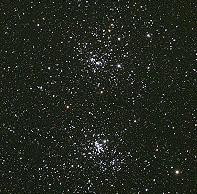BRIDGEPORT, WV - (S-M) One of our favorite objects is once again in the night sky. The famous Double Cluster in Perseus is visible to persons with a small telescope.
In the past, the cluster was visible with the naked eye as a faint blur near Cassiopeia. Unfortunately, light pollution has made it invisible from many locations. Still, the cluster is quite easy to find with a small telescope by scanning the sky just southeast of Cassiopeia.
"The Double Cluster is so large that you really don't need or want a large telescope to see it," said Senior Editor Glen Ward. "A four to six inch telescope of around 800mm focal length, when used with a 25mm eyepiece, will show the entire cluster area very well. Most larger telescopes don't have a wide enough field to show the entire complex. And, while binoculars will show it, most are just a bit small to show it well."
On the night of Thursday, September 25, our editors observed the Double Cluster with various instruments. All were in agreement that it was best seen in a 4.5" reflector. "An 80mm refractor was just too small to see the red giants which are sprikled through the star clouds," said Ward. "When using just the right telescope, the view is amazing."
The Double Cluster consists of two clusters properly known as NGC 884 and NGC 869. The clusters are considered to be open clusters, though the appearance of each cluster is similar to a globular cluster. While globulars are considered to be quite old, the stars in the Double Cluster are some of the youngest known, and are believed to have aged only a few million years. The clusters are around 7000 light years away, and it is believed that when we look at the clusters, we are looking out into the next spiral arm of our own Milky Way galaxy.
"The Double Cluster has long been a favorite object to view," said Glen Ward. "Even through the modern light polluted skies, it still looks good, and it gives us some sense of scale to know we are looking out into a more distant part of our own galaxy." - GW



The
TM
Astronomy From West Virginia
SEPTEMBER 29, 2008 - DOUBLE CLUSTER RETURNS TO EVENING SKY
Copyright 2008 Starry Mirror
